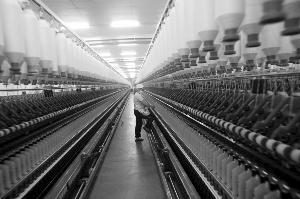Foreign news, the past week (March 8-14), India's cotton prices fell sharply, cotton yarn prices fell slightly. The price of PSF in India has remained stable, and polyester prices have risen.

According to statistics, in the past week, India's S-6 prices have fallen by Rs 300/km to Rs 41,000/km, down by 0.7%. Prices in Ludhiana have dropped by Rs 1 to Rs 199/kg. Yarn production Profit has recovered. In the past three months, India’s C30S prices have risen by 4.7%, while Pakistan’s has increased by 6.6%.
Due to the continued weakness of the rupee, Indian cotton yarns have maintained a relatively strong competitiveness in the international market. At present, the export price of cotton yarn in India is still at a high level of stabilization. The export price of JC30SFOB is US$3.35/kg, and the export price to China is increased by 2美/kg. In terms of blended yarns, due to the fall in China's PSF prices and the continuous appreciation of the renminbi exchange rate, India's polyester cotton dropped sharply. The T65/C35 30S price dropped by 7 cents/kg, a decrease of 2.5%.
The effect of decree decree since 2016 has continued to haunt small and medium-sized retailers engaged in denim business. This was combined with the introduction of the Goods and Services Tax (GST) and the rise in cotton prices, which apparently had an adverse effect on their business and caused losses.
Many retailers claim that their loyal customer base has been eroded and that cash flow has become quite slow. The decree or decree not only burned holes in their pockets, but also forced them to use cashless transactions, which were the cause of the loss.

According to Vishal Dubey, managing partner of the Indian company based in Bangalore, Denmark, “The effect of decree decree has remained on every retailer. They are now experiencing a different type of economic recession. They no longer exist in the system. In cash transactions, wholesalers insist that transactions take place online and it is very difficult for retailers to reap profits."
In the context of the economic downturn, retailers have no other choice but to cut the price of denim products. Another retailer, Suresh Agarwal, owner of Anant Apparels, headquartered in Ahmedabad, said: "Retailers are looking for other promotional means - by selling large quantities of goods."
Sanjay Soni, owner of Mas Enterprises in New Delhi, expressed a similar view: “Our turnover has had a series of impacts on other aspects and companies have stagnated. It is not just for retailers, manufacturers and distributors, but even wholesalers. Different cashless trading patterns."
As the core area of the Silk Road Economic Belt in the “Belt and Road” strategy, Xinjiang has seen rapid growth in the textile and apparel industry in recent years. In the 2018 spring and summer yarn exhibition, textile enterprises in Xinjiang region organized exhibition groups to participate in the exhibition.
According to the exhibition, the Xinjiang Pavilion has a total area of approximately 650 square meters and a total of 16 exhibiting companies. The main exhibits are high-grade combed cotton yarns, viscose yarns, air spinning, and vortex spinning using Xinjiang cotton as raw materials. The Xinjiang Pavilion presented the charm of Xinjiang yarn to everyone with its unique style.

In recent years, Xinjiang textile industry has achieved tremendous development under the support of policies, which is mainly reflected in the following aspects.
First, Xinjiang's textile investment has increased significantly in recent years. From 2014, Xinjiang’s textile and apparel industry’s investment in fixed assets has increased year by year. In 2017, the investment in fixed assets was 46.85 billion yuan. From 2014 to 2017, the total investment in fixed assets was 136.2 billion yuan.
Second, Xinjiang undertakes industrial transfer. Under the drive of preferential policies for textile and apparel in the country and the autonomous region, a large number of mainland textile and garment companies have invested in Xinjiang. The number of textile and garment enterprises in Xinjiang recorded growth from 560 at the beginning of 2014 to 2,703 at the end of 2017, an increase of 2,143 from three years ago. The number of companies investing and setting up factories in mainland China increased from tens of years ago to 616. The actual investment amount exceeds 80 billion yuan, accounting for more than 70% of the industry. Xinjiang has become the province with the largest number of industrial transfer enterprises in the western region of China.
Third, Xinjiang's textile production capacity has grown rapidly. The Xinjiang (including Bingtuan) cotton spinning spindles grew from 7 million spindles in 2014 to more than 17 million spindles (including air-spinning and vortex spinning) in 2017. The number of weaving fabrics has increased from 10,290 to more than 18,000, and the production capacity of garments has grown from 4000. The number of 10,000 pieces has grown to 200 million pieces, the carpet production capacity has increased from 400,000 square meters to 1.8 million square meters, and the viscose fiber production capacity has increased from 670,000 tons to 850,000 tons.
Fourth, textile employment has reached expectations. During the period of 2014-2017, Xinjiang’s textile and garment industry accumulated a total of 352,300 jobs, including 40,000 in 2014, 97,000 in 2015, 111.8 million in 2016, and 103,500 in 2017. At present, there are 480,000 people employed in the industry.
Affected by decree or decree payment
According to Vishal Dubey, managing partner of the Indian company based in Bangalore, Denmark, “The effect of decree decree has remained on every retailer.






